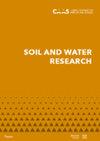The coupling of hillslope- and gully-erosion increases their controlling efforts: A case study in Liaoning Province, China
IF 1.7
4区 农林科学
Q4 SOIL SCIENCE
引用次数: 1
Abstract
The widespread hillslope- and gully-erosion in Liaoning Province of Northeast China, pose serious challenges to the local agricultural production. Hillslope- and gully-erosion have typically been studied separately; however, there has been little investigation on the relationship of these two types of erosion. In this study, the coupling relationship of the hillslope- and gully-erosion from the perspectives of erosion intensity and land use, as well as the slope gradient, aspect, and shape, was analysed. The study employed remote sensing and geographic information system techniques, and the universal soil loss equation and kriging were used to perform a macroscopic analysis. The results showed that gully-erosion was more severe compared with hillslope-erosion in the study area. The cultivated land has the highest level of human activities, therefore, the most intense hillslope- and gully-erosion. The threshold slope gradients for the hillslope- and gully-erosion are 14° and 6°, respectively. Above the threshold of 6°, the slope gradient is no longer the primary factor affecting the gully-erosion. Sunny slopes have observably more hillslope-erosion than shady slopes, and the highest hillslope-erosion is observed on the south-southeast-facing slopes. The effect of the slope aspect on the gully-erosion should not be ignored, as evidenced by the considerable gully density of the east-northeast-facing slopes which is obviously higher than for slopes with other slope aspects. The highest hillslope-erosion amount and gully density occur on concave slopes, followed by convex and straight slopes, and straight slopes have little effect on the hillslope-erosion, but have a marked impact on the gully-erosion. The results of this work may serve as a scientific reference for the comprehensive control of soil erosion across a slope-gully system in Northeast China.坡沟侵蚀耦合效应加大了对坡沟侵蚀的控制力度——以辽宁省为例
辽宁省广泛存在的坡沟侵蚀给当地农业生产带来了严重的挑战。斜坡侵蚀和沟壑侵蚀通常是分开研究的;然而,对这两种侵蚀类型之间的关系研究甚少。本文从侵蚀强度、土地利用、坡度、坡向、坡形等角度分析了坡沟侵蚀的耦合关系。本研究采用遥感和地理信息系统技术,采用通用土壤流失方程和克里格方程进行宏观分析。结果表明:研究区沟蚀比坡蚀严重;耕地是人类活动程度最高的地区,因此,坡地和沟沟侵蚀最为剧烈。坡面侵蚀和沟面侵蚀的阈值坡度分别为14°和6°。超过6°阈值后,坡度不再是影响沟蚀的主要因素。阳坡的坡面侵蚀明显大于阴坡,且东南向南坡面坡面侵蚀最大。坡向对沟蚀的影响不容忽视,东东向坡面沟密度明显高于其他坡向坡面。凹坡侵蚀量和沟壑密度最高,凸坡次之,直坡次之,直坡对坡面侵蚀影响不大,但对沟壑侵蚀影响显著。研究结果可为东北地区坡沟系统土壤侵蚀综合治理提供科学参考。
本文章由计算机程序翻译,如有差异,请以英文原文为准。
求助全文
约1分钟内获得全文
求助全文
来源期刊

Soil and Water Research
Water resources, Soil Science, Agriculture-WATER RESOURCES
CiteScore
4.60
自引率
0.00%
发文量
26
审稿时长
>12 weeks
期刊介绍:
An international peer-reviewed journal published under the auspices of the Czech Academy of Agricultural Sciences and financed by the Ministry of Agriculture of the Czech Republic. Published since 2006.
Thematic: original papers, short communications and critical reviews from all fields of science and engineering related to soil and water and their interactions in natural and man-modified landscapes, with a particular focus on agricultural land use. The fields encompassed include, but are not limited to, the basic and applied soil science, soil hydrology, irrigation and drainage of lands, hydrology, management and revitalisation of small water streams and small water reservoirs, including fishponds, soil erosion research and control, drought and flood control, wetland restoration and protection, surface and ground water protection in therms of their quantity and quality.
 求助内容:
求助内容: 应助结果提醒方式:
应助结果提醒方式:


